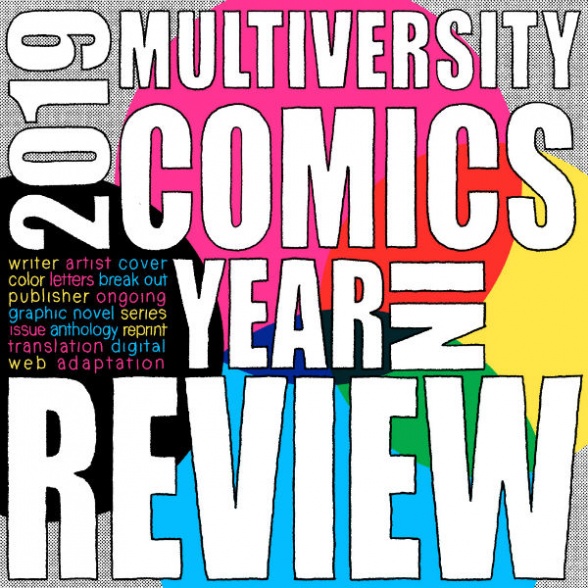
In years past, Best Limited Series was limited to five entries. But this year was such a strong one for the category, we expanded it to ten. And then, through ties, we got even more in the final article. This is what is known as a good problem to have.

10. Spider-Man: Life Story
“Spider-Man: Life Story” is unique because it gives the biggest character in the House of Ideas a definitive beginning and ending all in under 150 pages. Chip Zdarsky and Mark Bagley’s six issue miniseries is as inventive as it is classic; merging period-accurate politics, iconic Spider-Man tales from the time and the consistent throughline of a steadily aging Peter Parker who provides a maturing new outlook to old stories.
Chip Zdarsky’s writing is thoughtful in a way that is particularly rare in mainstream comics, after all “Immortal Hulk” only gets outright philosophical every second or third issue. “Life Story” echoes the bittersweet optimism that Kurt Busiek wrote so well in “Marvels” and “Superman: Secret Identity.” The series would almost feel anthological if it was not so deeply rooted in Peter Parker’s continuing struggle and sacrifice.
Mark Bagley is one of Spidey’s most prolific artists, seeming to always reach new heights. The main achievement here is how perfectly he handles the tone and style of every time period, both in terms of the setting and the characters who inhabit it. You can see that Peter Parker feels a different kind of sadness every issue because of just how well Bagley places the reader in the scene, breathing life and empathy into his figures. Mark Bagley has aged with Spider-Man and brings every facet of himself to the piece.
“Spider-Man: Life Story” is one of the best limited series of the year because it is so incredibly expansive while staying refreshingly exclusive. It is beautifully drawn, beautifully written and tells a story that pays respect to the tapestry of Spider-Man creators and the comic book industry that they grew from. – James Dowling
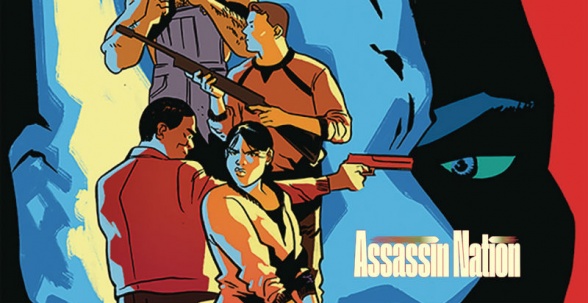
9 (tie). Assassin Nation
Don’t let Fuck Tarkington fool you. He’s tough as hell and sexually ambiguous. This Image/Skybound title would have deserved mentioning for the Best Limited Series of the year just for it’s punny title and a character with the name Fuck Tarkington. But Kyle Starks and Erica Henderson’s Assassin Nation gives us much more than that. Just flipping through the issues now while preparing to write this I had to stop several times to laugh out loud.
I think a good way to describe Assassin Nation is: it’s like a Bond movie but replace the rampant misogyny with a ton of humor. We get the over the top characters, incredible action sequences, and clever twists. When I heard Erica Henderson was leaving “The Unbeatable Squirrel Girl” to do creator owned work I was excited. I knew that we would get a unique book in her amazing style, but I never expected the leap from a family friendly book to the decidedly mature “Assassin Nation” to feel so natural.
Over the course of five issues we are treated to an action packed, at times violent, frequently hilarious romp through the world of hired killers and crime lords. The book is always funny, always surprising, and highly recommended. – Matthew Vincenty

9 (tie). Dial H for Hero
I’ve been trying to think of the last time I read a comic book that was as reverential to an entire artistic history of a medium as the current iteration of “Dial H for Hero.” Mike Allred’s “Madman Atomic Comics” #3 famously sent its titular hero on a one-off quest that found his appearance contorting into the styles of dozens of different artists, from Tex Avery to Bill Watterson and everyone in between. Now imagine if there was an entire comic with that premise, and imagine if it were published by DC Comics of all outlets, perfectly utilizing one of its cult classic, under-appreciated properties.
Sam Humphries weaves a humorous and honestly affecting coming of age story of two disaffected high schoolers throughout, but the real draw is the faithful homage work that Joe Quinones does in aping the styles of his forebears and contemporaries in comics art. Every time one of our protagonists uses the H-dial, they’re transformed into a bizarre new superhero visually based on a comics creator that has come before. Quinones does a marvelous job evoking DC Comics stalwarts like Alex Ross and Jim Lee, sometimes mimicking not only the character design of the artist, but making specific aesthetic choices to warp the world around them to evoke the artist even further. Letterer Dave Sharpe modifies his work for each new aesthetic, as well, resulting in some of the most impressive lettering work in superhero comics this year.
Continued belowAnd while the H-dial always creates a superhero, it’s not always a superhero creator being referenced. Recent issues have featured keen visual references to Chris Ware, Los Bros Hernandez, and Mike Allred himself. All of this would be diminished if the story around it was no good, but each issue also features Quinones returning to his own wonderful style of comic art to ground the story around its characters, and to explore the lore of the “Dial H for Hero” canon itself. In a world where corporate comics are becoming more and more about churning out issues on a deadline that necessitates fill-in artists (“Dial H for Hero” issue #7 does feature a few other artists doing terrific work, as well) and a willingness to abandon visual continuity, it’s a minor miracle that DC Comics is publishing this love letter to comics history in the first place, but it doesn’t hurt that Quinones is apparently an artistic superhero himself. – Vince Ostrowski

9 (tie). These Savage Shores
“These Savage Shores” was the perfect storm of fine craft and storytelling. Ram V, Sumit Kumar, Vittorio Astone and Aditya Bidikar blend their talents to make a period narrative chock full of colonial tensions, intricate politics, tenderness and brutality. Oh, and vampires.
It’d be easy to create an overblown, dreary and cramped comic that’s as dusty as certain precursors in the genre, but Ram and Kumar hit the right balance of pulp and sophistication to make “These Savage Shores” gripping and, above all, entertaining. The book ends with a vampire fight on the grounds of a foreboding English estate, the sum total of the tired brutality of creatures long since meant for other worlds. Bishan is a compelling and deeply flawed hero, prone to epistolary rumination even as he’s driven to violence by circumstances out of his control – almost. The book brims with love in all its forms, and deep sorrow.
Kumar’s art is incredibly detailed, fine and stylized, and the book’s layouts are impeccably tailored. Kumar pulls off the intricacies of British ships as easily as he depicts lithe figures on foreign and familiar shores. Astone’s color palette is a moody feast designed to enhance Kumar’s line and juxtapose sun-baked vistas with Gothic nights. Bidikar’s lettering is a primer in making epistolary narration not only work, but enhance the total page.
Put simply, “These Savage Shores” can make you think, feel and laugh at the same time. It honors the medium’s pulp roots and pushes the boundaries of pacing, nuance and structure. The book’s got something for everyone, and for that reason alone it’s a must-read. – Christa Harader

8 (tie). American Carnage
“American Carnage” was part of, what turned out to be, the last batch of titles released under the Vertigo banner. And, aside from “Border Town,” which ended due to details of a certain member of the creative team’s past coming to light, “American Carnage” was the standout title of the batch. It’s not hard to see why; there have not been many series of this quality or, especially, bravery, in quite some time at DC.
Writer Bryan Hill was fearless when writing both the FBI and the white supremacists in the title, refusing to make one side ‘good’ and, rather, exposing the hypocrisies and cruelty on both sides. Leandro Fernandez crafted a book that looked every bit as deep and tortured as Hill’s scripts, putting you inside the agony, fear, and hopelessness that coursed through the veins of Richard Wright.
The book often left me feeling raw and sick at the end of it, but it challenged me and was rarely far from my mind days later. There need to be more comics like “American Carnage,” and hopefully, it isn’t too long before we get a worthy successor.
– Brian Salvatore

8 (tie). Murder Falcon
I’m a longtime metalhead. In 2015, I had a really scary health scare, nearly died, and changed a lot about my life. My name is Jake. All of these things are also true of the protagonist of Daniel Warren Johnson’s 2019 masterpiece “Murder Falcon.” Suffice to say, the book resonated with me hard. It was clear going in that “Murder Falcon” was going to be a silly book, like a gorgeously illustrated Tenacious D comic, but I didn’t realize that it would cut to the core of things. Of why silly, bombastic bullshit can effect us in such a deep way. The power of music, of monsters, and of bravery.
Continued belowDWJ is something else. He writes this comic with tender care, which is impressive considering one of the main characters is a mastodon. He also draws the book, creating scenes that perfectly marry images and words to form some sort of mega-comic. It’s beautiful to behold and the story is just the kind of silly that disarms you enough to get you in the heart when it counts. Heavy metal will slay all evil and Daniel Warren Johnson will keep making fabulous comic books year after year. – Jake Hill

7. Superman Smashes the Klan
With “Superman Smashes the Klan,” Gene Luen Yang and Gurihiru have provided a take on a radio drama from the 40s that is both respectful of the original and infinitely more nuanced. Yang’s best-known work, “American Born Chinese,” was an exploration of the Asian-American immigrant experience, and he previously created Chinese superheroes for DC in “New Super-Man.” Yang’s familiarity with both subjects leads to a remarkable complexity in this story of an Asian-American family under attack from the Klan. Each family member has a distinct perspective on the immigrant experience, all of which ultimately contrast with and enhance Superman’s immigrant story. There is a fascinatingly delicate handling of race issues here that examines the time period in a way the fiction of the time never did. At the same time, though, the team makes sure things remain fun and engaging the way all great superhero stories should.
Every panel of “Superman Smashes the Klan” radiates with the confidence that only exists between long-term collaborators. Pages are so perfectly designed and scenes so perfectly paced that it’s impossible to tell where Yang ends and Gurihiru begins. The three-issue, 72-page format, which they have exclusively worked with in their past projects, also allows for more organic pacing than one would typically see in a graphic novel, while retaining the thrills and issue-by-issue thematic strength found in the serialized format.
As an essential Superman story, an essential story about the immigrant experience, an essential story about social intolerance, and an extraordinary example of creative collaboration in comics, “Superman Smashes the Klan” has earned its spot on this list. – Nick Palmieri
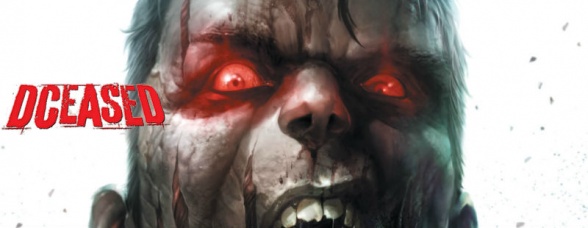
6. DCeased
To be honest, the “zombie apocalypse in superhero comics” arc has been done numerous times in recent memory, with at least one example from more than a decade ago being the original “Marvel Zombies” plot in 2005 and 2006 over at Marvel. “DCeased” isn’t even the first time something of this genre was used within DC Comics’s primary timeline, either, with the prominence of “Blackest Night” in 2008 and 2009. With examples like those, it can become difficult to be enthusiastic about the announcement of yet another story in that vein. The entire concept seemed overdone… and then “DCeased” came along, proving all of those assumptions dead wrong.
Rather than shamble along with the same arc that many have seen before, Tom Taylor drives the audience through a deadly menagerie of horror, throwing monsters at readers and the threat (and achievement) of destruction on an unprecedented scale, taking cues from the classics of George A. Romero along the way. Thanks to the series’s existence as an Elseworld, anything goes, and rather than just indulge in the terror and bloody violence, Taylor also takes the time for quieter moments or even comedy, even giving vast amounts of character development as sworn enemies are forced to work together by circumstance.
While Taylor’s script is brilliant, Trevor Hairsine’s artwork truly lets it shine. The thin, careful pencils show the intricacies of emotional response in every person, demonstrating the sheer monstrosity of the Anti-Living as much as the vulnerabilities and strengths of the living. Moments of needing to come face to face with a loved one turned ravenous never cease to be heartbreaking as he draws them, while the literal breaking of hearts through combat also is enough to cause readers to wince with each strike.
Rain Beredo’s colors, much like those he provides for “The Curse of Brimstone,” deepen the terror and despair present throughout “DCeased.” With the colors of the likes of the famous DC trinity of Batman, Superman, and Wonder Woman pressed into harsh relief against splashes of blood and even the devouring light of wide-scale annihilation, Beredo demonstrates how even the light of day is not enough to face down the corrupted Anti-Life Equation at its height. – Greg Ellner
Continued below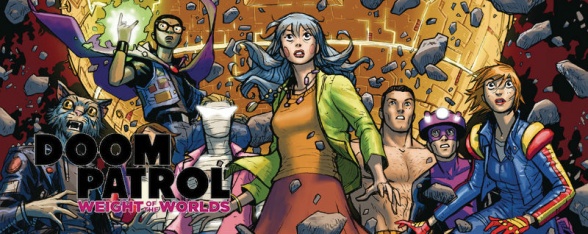
5. Doom Patrol: Weight of the Worlds
For my money, no other comic was willing to break the rules as consistently as “Doom Patrol: Weight of the Worlds.” I was largely trying to ignore the series because of the past reputation of the title having an inconsistent shipping schedule. The rotating slate of artists on the book made it impossible to ignore from a visual standpoint. Each issue of this series has attracted subversive creators who lend an eye toward the irreverent world of Doom Patrol. So far, readers have been treated to some of the best artists in the industry including Jeremy Lambert, James Harvey, Becky Cloonan, Evan “Doc” Shaner and Nick Pitarra. The line-up of rotating artists has imbued tons of energy into the title and makes every single issue feel novel. When readers are switching from the crisp, smooth linework of Evan “Doc” Shaner to the bombastic, ambitious pencils of Nick Pitarra the only through-line I can find is that DC likes great artists on “Doom Patrol: Weight of the Worlds” and I don’t have any problem with it.
Authors Gerard Way and Jeremy Lambert have done an excellent job creating a story tailored for each specific artist. Lambert and Way give Nick Pitarra a crazy script full of Flex Mentallo. James Harvey was given the opportunity to craft beautiful tale featuring a subplot involving Robotman. Becky Cloonan and Michael Conrad’s contribution crafted a very grounded Doom Patrol story that got progressively more odd as the issue concluded. Way and Lambert tell a dizzying narrative that is full of ideas and new status quos for these characters. The way continuity is handled in the pages of “Doom Patrol: Weight of the Worlds” is completely absurd. At any point in time, Lambert and Way aren’t afraid to literally name drop other creators in-story that have worked on the property. The most overt homages to past stories came in issue #5 from writers Becky Cloonan and Michael Conrad. The story contained a protagonist who literally tacked a ‘Young Animal’ poster to the wall.
The series does a phenomenal job spotlighting each member of the Doom Patrol cast as opposed to just shining the spotlight on a few members. It is hard to make the case that any one hero aside from Robotman could be presented as a protagonist. The irreverence of the series as a whole is as sharp as some of the moments of drama in the title. The last couple pages of the first issue are some of the saddest “Doom Patrol” pages Way and Lambert have ever written. The debut also contains the pure comedic relief joy who is Corban the Orb Ball. Despite the radical doses of humor and absurdity, Way, Lambert and the art team craft strong emotional moments in every issue. “Doom Patrol” isn’t quite a comedy or a drama and all the creators telling the story seem to agree on that key point.- Alexander Jones

4. Silver Surfer: Black
How do you take a much beloved character and do something new with them, while never straying far from what made them popular in the first place? You take a page from Donny Cates’s playbook. Cates is at the top of his game with his various connected Marvel books and “Silver Surfer: Black” is one of the best for a few reasons. It does a fantastic job of bringing in readers who may only know the titular hero in the rudimentary sense or have followed Marvel lore for years. It’s a soft re-introduction that never tries to hard to pander to newcomers.
As one of the best limited series of 2019 this story has an excellent cerebral and insane style that feels both new to the character and fully embraces the wild cosmic aspects from older Surfer stories. In just five issues, this arc puts the hero through space travel hell. Thrown through a black hole to the beginning of time, reluctantly pairing up with Ego the Living Planet, waging a battle of the ages with Knull – the Symbiote God, eons before the rest of the universe would have to deal with those pesky, sticky parasites, and giving Silver Surfer a new purpose. This series has it all. It strong stands on its own and ties in nicely with a few other on-going Marvel stories.
Continued belowTo fully capture the mind-blowing Cates teamed up with penciler Tradd Moore. Moore is a perfect choice for this story. He fully understands how to delve into cosmic psychedelia and run with it. Playing with multiple characters that would benefit from being drawn as a sort of organic liquid or have a sense of living fluidity, his illustrations are exactly the right style for this beautifully bonkers book. Colored by the one and only Dave Stewart, you have a recipe for perfection. Even if the story isn’t your typical cup of tea, the artwork is something to marvel at (no pun intended) with the turn of every page. Whether you enjoy it in conjunction with its connected stories, or on its own, there is no denying that “Silver Surfer: Black” is one of the best limited series to hit shelves in 2019. – Christopher Egan

3. The White Trees
When I first saw the solicits for “The White Trees,” I was apprehensive. The previews looked gorgeous and a team of Kris Anka, Chip Zdarsky, Matt Wilson, and Aditya Bidikar felt like a dream collaboration, but two issues seemed awfully brief. The scope looked epic and the pitch of the story seemed to promise a big fantasy drama, but cramming that into just two issues seemed destined to shortchange what could have been a great book.
As it turns out, I was both right and wrong—“The White Trees” is both the perfect length and far too short. Crucially, two issues was the exact right number for this narrative. It packs in stunning imagery, embraces its characters’ queerness, and moves from scene to scene without a hint of abruptness. The magic trick of “The White Trees” is that it feels larger than its format while fitting perfectly into its boundaries, never feeling like it is straining to be something larger.
The creators built a full world of nuanced characters and an emotional narrative tinged with regret. Anka and Wilson composed one of the most kinetic and engaging action sequences I’ve ever read in a comic. All of this is brilliantly accomplished in two issues, giving each story beat—up to and including its devastating finale—the space it needs to sing.
Yet I long to spend more time in this world, with Sir Krylos the Bold, Sir Dahvlan the Swift, and Sir Scotiar of Blacksand, with this fantastic country filled with somber magic and an implied bloody past. That’s not a knock on “The White Trees,” really. That’s a testament to how much this book and this world grabbed me, and how much of a knockout this miniseries truly was. Two issues was enough for this story, but it wasn’t enough for me, and I hope we get the chance to journey back to The Fourth Realm with this creative team. – Reid Carter

2. Powers of X
Jonathan Hickman injected pure and potent life energy into the X-Men with “House of X” and “Powers of X” this year. In particular, the latter series brought some major revelations and story beats to the table. The series opened with a bang, presenting us four different significant moments through time that explored some serious sci-fi storytelling involving the big bads like a new and improved Nimrod and a satisfyingly complex Phalanx. Then we got the wild plot twist that Moira MacTaggert was a mutant with the power of reincarnation, that opened up another layer and direction to exploring timelines in Marvel canon. Coupled with that, we got some killer art from RB Silva that rendered complex alien futures, from jungles to cold, robotic cities each and every issue. With Marte Gracia coloring, we also got some of the most vibrant and visually exciting superhero battles, especially with the new characters from the year 100 timeline.
What I loved most about reading “Powers of X” this year, however, was the community that gathered around it. Not for a long time have I seen people discuss, theorize and analyze so much over a book from Marvel or DC, and yet “Powers” and “House” both sustained this discussion and excitement over their entire release period. It felt special to readers and dedicated X-Fans who had been so used to lackluster stories over the last five years, so we clutched onto it and fervently theorized about the future of the Krakoan society as much as we would. I feel sorry for those who will be reading this series after the fact, as they won’t get to participate in such a fun week-to-week period of wonder, even if this book still manages to be a great standalone series in its own right. In that way, I guess it’s apt that it’s taken out the top two spots for best limited series on this list. The X-Men are good again, guys, and it felt great to be there when it happened. – Rowan Grover
Continued below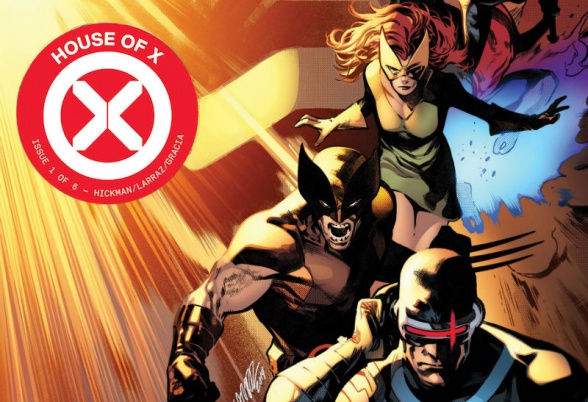
1. House of X
For all the times that a comic promises to shake up the status quo and change everything about its series, very few comics actually do that. “House of X,” on the other hand, actually did – the “X-Men” comics have been changed in a way that’s being felt across all the titles. In fact, it’s such a major shift that both “House of X” and “Powers of X” took the top two spots in this list. Why? Well, where do we begin?
“House of X” is a unique story in Marvel. The impacts, implications and mysteries persist even after the series ended, continuing through every other book with an X in its name. From the first page, where Professor Xavier welcomes mutants reborn as they emerge from strange eggs, we’re filled with questions that slowly get answers. Or if not answers, at least enough context to begin piecing it together.
We’re quickly introduced to the concept of the new mutant homeland of Krakoa, the wonder drugs that give them an economic and socio-political edge, and even (perhaps most shockingly of all) a happy Wolverine. Each issue finds new ways to mix things up and keep us surprised, such as issue 2’s revelation of Moira’s true powers and history and all the once-dead mutants brought back to life. The stakes rise just as quickly with the introduction of the Orchis Forge.
Sacrifice, cycles of death and rebirth, conspiracy, redemption, religious motifs – just how much can a single comic contain? Jonathan Hickman creates an almost mythical telling of the story of the X-Men and the new mutant homeland. The way the story unfolds, the way the characters speak, feels larger than life in so many ways. Yet there’s just enough of an ominous spark in some of the dialogue and plans in motion that there’s a sense of caution and tension to accompany every new revelation. It feels like there are so many secrets and plans that Hickman has plotted out years in advance, and every chapter sheds a little light on an even bigger story.
All the while, the artistic team provides visuals equally befitting this epic tale. Pepe Larraz provides detailed scenery, powerfully angled imagery that makes these characters feel huge, and good visual storytelling. Marte Gracia and David Curiel add colors that make everything stand out cleanly and pleasing to see, with just enough darkness added to keep us on our toes.
While “House of X” can easily be read and enjoyed as its own series, it’s one half of a greater story. The comic came out in alternating issues with “Powers of X,” telling an even grander story. To see how that works out, though, I now refer you back to our #2 pick for “Best Limited Series.” – Robbie Pleasant






